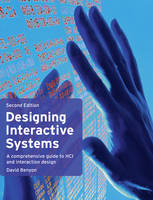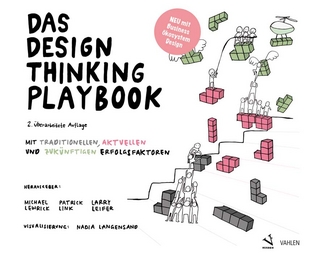
Designing Interactive Systems
Addison Wesley Longman (Verlag)
978-0-321-43533-0 (ISBN)
- Titel erscheint in neuer Auflage
- Artikel merken
David Benyon is a professor of Human Computer Systems at Edinburgh Napier University, UK. He has extensive experience as a researcher, designer and writer in interaction design and HCI.
Table of Contents:
Guided tour
Preface
Publisher's acknowledgements
Part 1: Essentials of designing interactive systems
1 Designing interactive systems
1.1 The variety of interactive systems
1.2 The concerns of interactive systems design
1.3 Being digital
1.4 The skills of the interactive systems designer
1.5 Why being human-centred is important
2 PACT: a framework for designing interactive systems
2.1 Introduction
2.2 People
2.3 Activities
2.4 Contexts
2.5 Technologies
2.6 Scoping a problem with PACT
3 The process of human-centred interactive systems design
3.1 Introduction
3.2 Developing personas and scenarios
3.3 Using scenarios throughout design
3.4 A scenario-based design method
4 Usability
4.1 Introduction
4.2 Accessibility
4.3 Usability
4.4 Acceptability
4.5 Design principles
5 Experience design
5.1 Introduction
5.2 Engagement
5.3 Designing for pleasure
5.4 Aesthetics
5.5 Service design
6 The Home Information Centre (HIC): a case study in designing interactive systems
6.1 Introduction
6.2 Scenarios for the HIC
6.3 Evaluating early interface prototypes
6.4 A first design
6.5 The second interface design
Part 2: Techniques for designing interactive systems
7 Understanding
7.1 What are requirements?
7.2 Participative design
7.3 Interviews
7.4 Questionnaires
7.5 Probes
7.6 Card sorting techniques
7.7 Working with groups
7.8 Field work: observing activities in situ
7.9 Artefact collection and 'desk work'
8 Envisionment
8.1 Finding suitable representations
8.2 Basic techniques
8.3 Prototypes
8.4 Envisionment in practice
9 Design
9.1 Introduction
9.2 Conceptual design
9.3 Metaphors in design
9.4 Conceptual design using scenarios
9.5 Physical design
9.6 Designing interactions
10 Evaluation
10.1 Introduction
10.2 Expert evaluation
10.3 Participant-based evaluation
10.4 Evaluation in practice
10.5 Evaluation: further issues
11 Task analysis
11.1 Goals, tasks and actions
11.2 Task analysis and systems design
11.3 Hierarchical task analysis
11.4 GOMS: a cognitive model of procedural knowledge
11.5 Structural knowledge
11.6 Cognitive work analysis
12 Contextual Design 1: the contextual interview and work modelling
12.1 Introduction
12.2 Contextual inquiry
12.3 Contextual design: work modelling
12.4 Flow models
12.5 Sequence models
12.6 Artifact models
12.7 The cultural model
12.8 The physical model
13 Contextual Design 2: from models to design
13.1 Introduction
13.2 The affinity diagram
13.3 Consolidation
13.4 Developing a vision
13.5 Constructing a storyboard in Contextual Design
13.6 The user environment design (UED)
13.7 Paper prototyping
13.8 Applications of Contextual Design
14 Interface design: visual aspects
14.1 Introduction
14.2 Command languages
14.3 Graphical user interfaces
14.4 Interface design guidelines
14.5 Data visualization
15 Interface design: multimodality and mixed reality
15.1 Introduction
15.2 Using sound at the interface
15.3 Tangible interaction
15.4 Getting a feel for tangible computing
15.5 Wearable computing
Part 3: Contexts for designing interactive systems
16 Designing web sites
16.1 Introduction
16.2 Website development
16.3 The information architecture of websites
16.4 Navigation design for websites
16.5 Case study: designing the Robert Louis Stevenson website
17 Web 2.0
17.1 Introduction
17.2 Background ideas
17.3 Social networking
17.4 Sharing with others
17.5 Cloud computing
18 CSCW: working in groups
18.1 Introduction
18.2 Issues for cooperative working
18.3 Technologies to support cooperative working
18.4 Collaborative virtual environments
19 Agents and avatars
19.1 Agents
19.2 Adaptive systems
19.3 An architecture for agents
19.4 Other applications of agent-based interaction
19.5 Avatars and conversational agents
20 Ubiquitous computing
20.1 Uniquitous computing
20.2 Information spaces
20.3 The information architecture of information spaces
20.4 Home environments
20.5 Navigating ubiquitous computing environments
21 Mobile computing
21.1 Introduction
21.2 Context awareness
21.3 Understanding in mobile computing
21.4 Design
21.5 Evaluation
Part 4: Foundations of designing interactive systems
22 Memory and attention
22.1 Introduction
22.2 Memory
22.3 Attention
22.4 Human error
23 Emotion and affective computing
23.1 Introduction
23.2 Psychological theories of emotion
23.3 Detecting and recognizing emotions
23.4 Expressing emotion
23.5 Potential applications and key issues for further research
24 Cognition and action
24.1 Human information processing
24.2 Situated action
24.3 Distributed cognition
24.4 Embodied cognition
24.5 Activity theory
25 Social interaction
25.1 Introduction
25.2 Human communication
25.3 People in groups
25.4 Presence
25.5 Culture and identity
26 Perception and navigation
26.1 Introduction
26.2 Visual perception
26.3 Non-visual perception
26.4 Navigation
References and bibliography
Index
| Erscheint lt. Verlag | 1.4.2010 |
|---|---|
| Sprache | englisch |
| Maße | 189 x 245 mm |
| Gewicht | 1170 g |
| Themenwelt | Informatik ► Software Entwicklung ► User Interfaces (HCI) |
| ISBN-10 | 0-321-43533-8 / 0321435338 |
| ISBN-13 | 978-0-321-43533-0 / 9780321435330 |
| Zustand | Neuware |
| Informationen gemäß Produktsicherheitsverordnung (GPSR) | |
| Haben Sie eine Frage zum Produkt? |
aus dem Bereich



